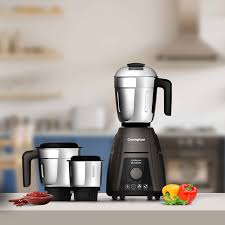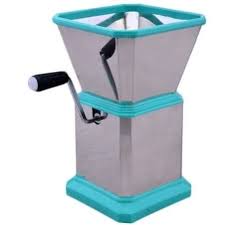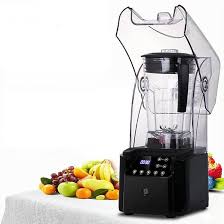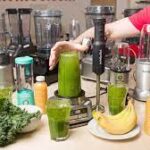A grinder is an essential tool for anyone who enjoys freshly ground coffee, spices, or even needs to grind grains or nuts for cooking and baking. With various types of grinders available on the market, selecting the right one for your needs can be overwhelming. In this guide, we’ll explore the different types of grinders, their uses, and tips for choosing the perfect grinder for your kitchen.
Types of Grinders
1. Coffee Grinders
Coffee grinders are designed specifically to grind coffee beans to the desired consistency for brewing. There are two main types of coffee grinders: blade and burr.
- Blade Grinders: These are more affordable and use a rotating blade to chop the beans. They are simple to use but can produce uneven grinds, which might affect the taste of your coffee.
- Burr Grinders: These use two revolving abrasive surfaces (burrs) to grind the coffee beans more uniformly. They are preferred by coffee enthusiasts for producing a consistent grind size, which is crucial for making quality coffee.
2. Spice Grinders
Spice grinders are used to grind spices into powder for cooking. They can be either manual or electric.
- Manual Spice Grinders: Often designed as small mills, these require hand-cranking to grind spices. They offer control over the grind size but require more effort.
- Electric Spice Grinders: These are convenient and fast, ideal for those who grind spices frequently. They come with various settings for different grind sizes.
3. Meat Grinders
Meat grinders are used to grind various types of meat into mince for making sausages, burgers, or meatloaf.
- Manual Meat Grinders: These are operated by hand and are suitable for small quantities of meat. They are durable and do not require electricity.
- Electric Meat Grinders: These are more powerful and efficient, suitable for larger quantities of meat. They often come with attachments for making sausages and other meat products.
4. Grain Grinders
Grain grinders are used to grind grains into flour for baking and cooking. They can also be manual or electric.
- Manual Grain Grinders: These are typically more affordable and portable but require significant effort to operate.
- Electric Grain Grinders: These are efficient and can grind large quantities of grains quickly. They are ideal for frequent use and can produce fine, consistent flour.
5. Herb Grinders
Herb grinders are used to grind herbs and small plant material, commonly used in culinary and medicinal preparations.
- Manual Herb Grinders: These are small, portable, and typically used for grinding small quantities of herbs.
- Electric Herb Grinders: These provide quick and efficient grinding for larger quantities of herbs, suitable for both culinary and medicinal uses.
Choosing the Right Grinder
When selecting a grinder, consider the following factors:
1. Purpose: Determine what you will primarily use the grinder for – coffee, spices, meat, grains, or herbs. This will help you choose the appropriate type.
2. Capacity: Consider how much you need to grind at once. For example, if you frequently host gatherings and need large quantities of ground coffee or meat, opt for a larger, more powerful grinder.
3. Consistency: For coffee and certain spices, consistency in grind size is crucial for the best flavor. Burr grinders for coffee and electric grinders with adjustable settings for spices are ideal for achieving consistent results.
4. Ease of Use: Decide whether you prefer a manual grinder, which requires more effort but offers more control, or an electric grinder, which is convenient and fast but may be more expensive.
5. Maintenance: Consider how easy the grinder is to clean and maintain. Some grinders have detachable parts that are dishwasher-safe, making cleaning easier.
6. Budget: Grinders come in a range of prices. Determine your budget and find a grinder that offers the best features and performance within that range.
A grinder is a versatile tool that can enhance your culinary creations, from freshly ground coffee to homemade sausages and finely milled flour. By understanding the different types of grinders and their uses, you can select the perfect one for your kitchen. Whether you choose a manual or electric grinder, investing in a quality grinder will ensure you enjoy the freshest and most flavorful ingredients in your cooking and beverages.

The Advantages of Using a Manual Grinder
In a world where electric appliances dominate the kitchen, manual grinders remain a popular choice for many. These versatile tools offer a unique blend of control, tradition, and functionality. Whether you’re grinding coffee, spices, or grains, a manual grinder can be a valuable addition to your kitchen. Let’s explore the benefits of using a manual grinder and how to choose the right one for your needs.
What is a Manual Grinder?
A manual grinder is a hand-operated device used to grind various ingredients such as coffee beans, spices, nuts, grains, and herbs. Unlike electric grinders, manual grinders require physical effort to operate, offering a tactile and satisfying grinding experience.
Benefits of Using a Manual Grinder
1. Precision and Control
Manual grinders allow you to control the grinding process, ensuring the perfect consistency for your needs. This is particularly important for coffee enthusiasts who seek a specific grind size for different brewing methods, such as espresso, French press, or pour-over.
2. Portability
Manual grinders are compact and lightweight, making them ideal for travel, camping, or small kitchens. You can enjoy freshly ground coffee or spices anywhere, without the need for electricity.
3. Quiet Operation
Unlike electric grinders, manual grinders operate quietly. This is a significant advantage if you want to avoid disturbing others in your household early in the morning or late at night.
4. Durability
Manual grinders are often built to last, with high-quality materials such as stainless steel, ceramic, or heavy-duty plastic. They have fewer moving parts than electric grinders, reducing the risk of mechanical failure.
5. Cost-Effective
Manual grinders are generally more affordable than their electric counterparts. They also don’t require electricity, which can save on energy costs over time.
6. Eco-Friendly
Using a manual grinder reduces your carbon footprint. Without the need for electricity, you contribute to energy conservation and reduce the impact on the environment.
Types of Manual Grinders
1. Coffee Grinders
Manual coffee grinders are designed to grind coffee beans to the desired consistency. They often feature adjustable settings to achieve different grind sizes, from fine espresso to coarse French press.
2. Spice Grinders
Manual spice grinders allow you to grind whole spices into fresh, flavorful powder. They are perfect for enhancing the taste of your dishes with freshly ground spices.
3. Grain Grinders
Manual grain grinders can grind various grains into flour, ideal for baking and cooking. They are particularly useful for those who prefer to use freshly milled flour in their recipes.
4. Herb Grinders
Manual herb grinders are used to grind herbs and small plant material, commonly used in culinary and medicinal preparations.
Choosing the Right Manual Grinder
When selecting a manual grinder, consider the following factors:
1. Material
Look for grinders made from durable materials such as stainless steel, ceramic, or high-quality plastic. Stainless steel and ceramic grinders are known for their longevity and ability to grind evenly.
2. Size and Capacity
Choose a grinder size that fits your needs. Smaller grinders are portable and suitable for travel, while larger grinders are better for home use and can handle larger quantities of ingredients.
3. Adjustability
Ensure the grinder has adjustable settings for different grind sizes. This is particularly important for coffee grinders, where grind size can significantly impact the flavor of your brew.
4. Ease of Use
Consider the ease of use and ergonomics of the grinder. Look for a design that is comfortable to hold and easy to operate, with a smooth grinding mechanism.
5. Maintenance
Choose a grinder that is easy to disassemble and clean. Some grinders come with removable parts that are dishwasher-safe, making maintenance hassle-free.
A manual grinder is a versatile and valuable tool for any kitchen. It offers precision, control, and a satisfying hands-on experience. Whether you’re grinding coffee, spices, or grains, a manual grinder allows you to enjoy freshly ground ingredients anywhere, anytime. By considering factors such as material, size, adjustability, ease of use, and maintenance, you can choose the perfect manual grinder to suit your needs. Embrace the tradition and control that a manual grinder brings, and enhance your culinary creations with freshly ground ingredients.


The Ultimate Guide to Mechanical Blenders
A mechanical blender is a versatile and essential kitchen appliance that can simplify your cooking and meal preparation. From blending smoothies to pureeing soups and crushing ice, mechanical blenders offer a range of functionalities that make them a valuable addition to any kitchen. In this guide, we’ll explore the features, benefits, and tips for choosing the perfect mechanical blender for your needs.
What is a Mechanical Blender?
A mechanical blender, commonly known simply as a blender, is a kitchen appliance used to mix, puree, or emulsify food and other substances. It typically consists of a jar with a rotating metal blade at the bottom, powered by an electric motor housed in a base.
Benefits of Using a Mechanical Blender
1. Versatility
Mechanical blenders can perform a variety of tasks, such as blending smoothies, making purees, crushing ice, and even grinding nuts and seeds. This versatility makes them indispensable for both everyday cooking and special recipes.
2. Time-Saving
Blenders significantly reduce the time needed for food preparation. They can quickly blend ingredients to the desired consistency, saving you valuable time in the kitchen.
3. Consistency
Blenders ensure a consistent texture for your recipes. Whether you’re making a creamy soup or a smooth smoothie, a mechanical blender can achieve a uniform blend every time.
4. Nutrient Retention
Blending fruits and vegetables retains most of their nutrients, allowing you to enjoy healthy and nutritious meals and drinks. Smoothies made with a blender are an excellent way to consume a variety of vitamins and minerals.
5. Easy to Use
Mechanical blenders are user-friendly and typically come with straightforward controls. Most models feature multiple speed settings and pre-programmed functions to handle different tasks effortlessly.
Key Features to Look for in a Mechanical Blender
1. Motor Power
The power of the motor is a crucial factor in a blender’s performance. Higher wattage motors (typically 500-1500 watts) can handle tougher ingredients like ice and frozen fruits more efficiently.
2. Blade Design
Look for blenders with durable, stainless steel blades designed to crush and blend ingredients thoroughly. Some models feature multi-level blades for enhanced blending performance.
3. Jar Material and Capacity
Blender jars are commonly made from glass, plastic, or stainless steel. Glass jars are sturdy and don’t retain odors, while plastic jars are lighter and more durable. Stainless steel jars are the most durable and best for heavy-duty use. Choose a jar capacity that suits your needs, from single-serving sizes to larger family-sized options.
4. Speed Settings and Controls
A good blender should offer multiple speed settings and pulse functions to provide better control over the blending process. Some high-end models also come with pre-programmed settings for specific tasks like smoothies, soups, and ice crushing.
5. Ease of Cleaning
Choose a blender with dishwasher-safe parts for easy cleaning. Removable blades and a wide jar opening can also simplify the cleaning process.
6. Safety Features
Safety features like a secure lid, non-slip base, and automatic shut-off can prevent accidents and ensure safe operation.
Popular Types of Mechanical Blenders
1. Countertop Blenders
Countertop blenders are the most common type, designed for a variety of tasks from blending to pureeing. They are typically larger and more powerful, suitable for everyday kitchen use.
2. Personal Blenders
Personal blenders are compact and designed for single servings. They are ideal for making smoothies and shakes on the go. These blenders often come with portable blending jars that double as travel cups.
3. Immersion Blenders
Also known as hand blenders, immersion blenders are handheld devices used for blending ingredients directly in the container they are being prepared in. They are perfect for soups, sauces, and small blending tasks.
4. High-Performance Blenders
High-performance blenders are powerful machines capable of handling tough ingredients and extensive use. They often come with advanced features and are ideal for serious cooks and professionals.
A mechanical blender is a versatile and indispensable tool in any kitchen, offering convenience, efficiency, and consistent results. Whether you’re blending smoothies, pureeing soups, or crushing ice, choosing the right blender can elevate your culinary creations. By considering factors such as motor power, blade design, jar material, and ease of cleaning, you can find the perfect mechanical blender to suit your needs and enhance your cooking experience.










